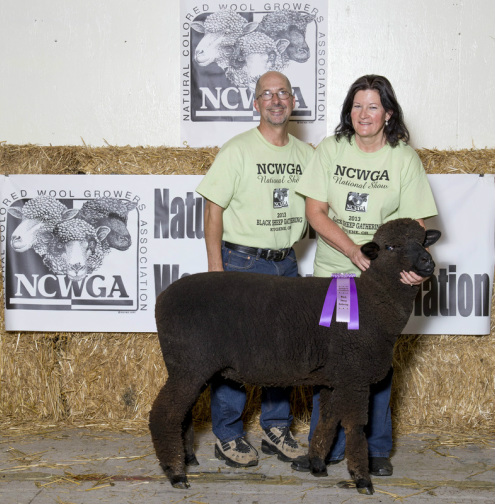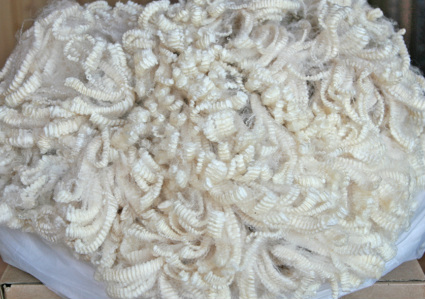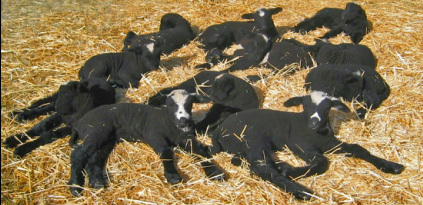Corriedale Sheep
 NCWGA National Show Reserve Champion Ewe and Champion Fleece Award
NCWGA National Show Reserve Champion Ewe and Champion Fleece Award
At Marble Peaks Ranch we raise Corriedale sheep. We chose the Corriedale breed because it is a true dual-purpose breed that can produce both superb wool and superior meat lambs. Corriedale sheep are medium to large-framed, with rams weighing from 180 to 280 pounds and ewes from 150 to 250 pounds. We find that Corriedale sheep produce first-rate grass-fed lambs. Our lambs reach their market weight of 130 to 160 pounds in 7 to 8 months exclusively on grass. Our experience with Corriedales is that the breed is quite hardy in both cold winter (down to 10 F) and hot summer (up to 105 F) temperatures. Corriedales have a medium wool, with a fiber diameter of 25 to 32 microns, and a staple length of 3 to 6 inches. Corriedale wool has broad appeal with handspinners for its versatility, ease of spinning, and its bold, even crimp that creates elastic yarns.
 Fleece of Our Current White Stud Ram
Fleece of Our Current White Stud Ram
The predominant goal of our breeding program is to produce sheep with sensational fleeces. Our definition of sensational means wool that catches your eye and tempts you to touch it. More specifically, it means we are aim for a true Corriedale breed-character wool with bold crimp, bright luster, and soft handle. Very few sheep with these qualities have been seen in the United States until recently.
Beyond beautiful fleeces, we do recognize that sheep must be functional. Our flock ranges over sixty acres of pasture; they are not pampered. We require our Corriedale lambs to have sound conformation, ample muscling, and a strong rate of gain on grass without supplemetation. We select our ewes for ease of lambing, strong maternal instinct, and appropriate milk production. We select our rams for calm temperament and high fertility.
We raise both white and natural colored Corriedale sheep, although presently colored sheep represent the majority of our flock. The white Corriedales are purebred and registered with the American Corriedale Association. The colored Corriedales are as close to purebred as can be obtained in the United States and are registered with the Natural Colored Wool Growers Association. We are enhancing the Corriedale breed character in our colored flock by using purebred white Corriedale stud rams.

Here is a brief summary of the characteristics of coloration in our flock. Our natural colored lambs are born black or very dark gray in color. As they mature, their wool gradually lightens to shades of gray. This change can begin at a few months old, but generally occurs after a year of age. A small percentage of our flock will retain their deep black color for most of their lives.
A simplistic version of the genetics of color in our Corriedale flock is that color is dominant and white is recessive. A colored sheep (colored phenotype) can have either one copy (heterozygous genotype) or two copies (homozygous genotype) of the allele for color. A white sheep (white phenotype) must have two copies of the white allele (homozygous genotype). A white sheep bred to a white sheep will always produce white offspring. A colored sheep that is homozyous, bred to other another colored sheep, will always produce colored offspring. If a white sheep is bred to a colored sheep, and the colored sheep is homozyous for color, then all the offspring will be colored. Where can the surprises come in? A colored sheep can be heterozygous, and have one color allele and one white allele. If a white sheep is bred to a heterozygous colored sheep, then on average half of the offspring will be colored and half will be white (not half of their bodies, half of the total number of offspring).
A simplistic version of the genetics of color in our Corriedale flock is that color is dominant and white is recessive. A colored sheep (colored phenotype) can have either one copy (heterozygous genotype) or two copies (homozygous genotype) of the allele for color. A white sheep (white phenotype) must have two copies of the white allele (homozygous genotype). A white sheep bred to a white sheep will always produce white offspring. A colored sheep that is homozyous, bred to other another colored sheep, will always produce colored offspring. If a white sheep is bred to a colored sheep, and the colored sheep is homozyous for color, then all the offspring will be colored. Where can the surprises come in? A colored sheep can be heterozygous, and have one color allele and one white allele. If a white sheep is bred to a heterozygous colored sheep, then on average half of the offspring will be colored and half will be white (not half of their bodies, half of the total number of offspring).